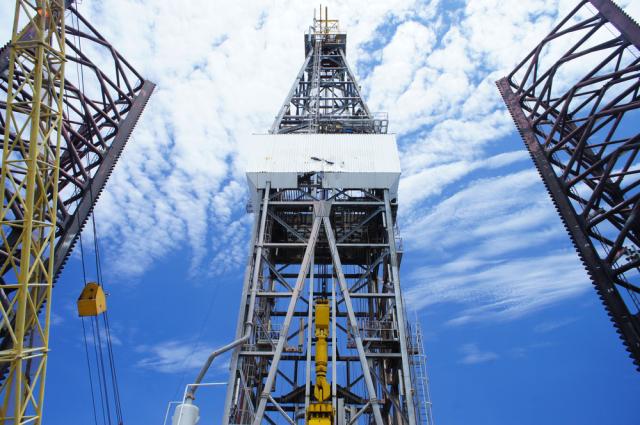
Offshore exploration activity is expected to pick up in several regions across the world. (Source: James Jones Jr./Shutterstock.com)
Improved market conditions, efficiency gains, cost reductions and free cash flow have given some oil and gas companies the confidence needed to step up offshore exploration activity.
But are analysts ready to call it a comeback?
Some parts of the world—so-called “hotspots”—are seeing a rise in offshore exploration activity as energy players chase potential oil and gas pay. Analysts say this activity combined with more opportunities to snatch up additional acreage being offered in licensing rounds and companies having the cash to spend support an exploration comeback.
“For Western Europe, we see a sharp pickup in 2019,” Nils-Henrik Bjurstrøm, senior project manager for Rystad Energy, said during a recent webinar.
Regional activity here is being led by Norway, where companies have high free cash flow generation and see low exploration costs. “All of that generates activity.”
Meanwhile, in the U.K., some wells delayed from 2018 to 2019 are facilitating growth, Bjurstrøm added, noting more licensing rounds are also forthcoming.
But the most important region to look out for this year when it comes to offshore exploration activity is Brazil, according to Rohit Patel, senior analyst for Rystad Energy.
Coming off a year with “momentum in drilling and licensing activity with focus on presalt,” the country is expected to see a rise in offshore exploration wells compared to recent years as companies such as state-run Petrobras, Equinor ASA, Royal Dutch Shell Plc and Exxon Mobil Corp. pick up the drilling pace. Work pledged during recent licensing rounds is expected to increase activity from 2020, he said.
The country is also home to what some analysts call the most highly watched well—the Petrobras-operated Peroba, a large presalt prospect in the Santos Basin. Brazil’s oil regulator ANP estimated Peroba, where drilling began in October, could hold about 5.3 billion barrels of oil in place.
Also among the world’s offshore exploration hotspots is Mexico, where Patel said more than 20 offshore exploration wells are expected to be drilled this year.
Since the industry reform started around 2014, 55 offshore blocks have been awarded, he said; however, few of these have been fulfilled in part due to regulatory uncertainties. But this is expected to change in the near term.
“The wildcats, particularly those in deep water, will be watched closely by the industry,” Patel said in his presentation. “Results from 2019 exploration will also play a large role in shaping industry’s perception of Mexico’s exploration potential.”
With seven high-impact wells on the horizon, Australia, in particular, is making an offshore exploration comeback, according to Patel.
Highlights anticipated this year include the Santos-operated Dorado appraisal wells, Woodside Energy’s Achernar and Sapura Energy’s Eagle—all located on the Northwest Shelf. The Great Australian Bight is also expected to be the site of a couple of wells being watched—Cooper Oil’s Annie/Elanora and Beach Energy’s Enterprise.
Meanwhile, exploration activity in West Africa could double this year as oil and gas players drill wildcat and appraisal wells in the Atlantic Ocean. A “massive uptick” in exploration activity was already evident from 2018 to 2019, according to Patel.
“We are seeing a lot of majors and exploration players lining up in this area, and we’ll see some interesting wells that are part of the drilling campaigns this year,” Patel said.
Activity will be seen offshore several countries in the West African region. These include Mauritania, where BP Plc is planning an appraisal well in Block C-8 and Total SA is considering a wildcat on Block C-9; Senegal, where BP and Woodside have lined up plans for appraisal wells and Oryx, African Petroleum Corp. Ltd. and Edison SpA are eyeing wildcats; and Ghana, where Exxon Mobil and Ghana National Petroleum Corp. each plan to drill a wildcat with Aker Energy drilling four appraisal wells.
The waters offshore Nigeria, Equatorial Guinea, Gabon and Angola will also see action from oil and gas companies, he said.
“We have a nice bit of activity around the globe and we are seeing a lot of activity picking up in a lot of countries where we have seen less activity in the past couple of years,” Patel added.
Velda Addison can be reached at vaddison@hartenergy.com.
Recommended Reading
CrownRock Offloads Oxy Shares Two Weeks After Closing $12B Deal
2024-08-15 - Underwriters of the offering agreed to purchase CrownRock’s Occidental stock at $58.15 per share, which will result in approximately $1.719 billion in proceeds before expenses.
Affiliates of Oxy to Sell Western Midstream Common Units
2024-08-13 - Western Midstream Partners announced the pricing of the underwritten secondary public offering of its common units.
Dividends Declared in the Week of July 22
2024-07-25 - Second quarter earnings are underway, and companies are declaring dividends.
Comments
Add new comment
This conversation is moderated according to Hart Energy community rules. Please read the rules before joining the discussion. If you’re experiencing any technical problems, please contact our customer care team.




